Here is a link to my final Photo Book: https://www.blurb.com/bookstore/invited/9554446/47ab8249f2f1668fdf3f73587a155cc1874bab3b

Here is a link to my final Photo Book: https://www.blurb.com/bookstore/invited/9554446/47ab8249f2f1668fdf3f73587a155cc1874bab3b

The images seen on the pages of this newspaper supplement are extracted from a variety of projects and final outcomes produced over a two-year academic programme of study by a group of A-Level photography students at Hautlieu School. In their final year the themes of Identity and Community offered a specific focus and through a series of creative challenges students developed a body of work that were inspired, partly from visiting heritage institutions to learn about aspects of Jersey’s unique history of immigration and exploring migrant communities and neighbourhoods in St Helier in a series of photo-walks. In the classroom additional inspiration was provided from workshops on NFTs (non-fungible token) and digital art, embroidery and textile art, animation and film-making, zine and photobook design led by professional artists, designers and teachers.
As part of the research and contextual studies students were asked to engage with some of the key questions raised by the Government of Jersey’s Island Identity project and explore through their own photographic studies how they interpret and identify distinctive qualities of island life. What can we learn from looking at a set of photographs produced by young islanders? At first sight they show us a seemingly random set of images of places, people and objects – some familiar, others surprising. On closer inspection each image is a visual sign and also a conundrum. For example, a fish stuffed in a plastic bottle may ask us to consider more closely our marine environment, commercial fishing or food consumption. As a combined sequence of images they represent different views that in many ways comment on a wider discussion on some of the primary objectives explored in the Island Identity project, such as ‘how we see ourselves’ and ‘how others see us.’
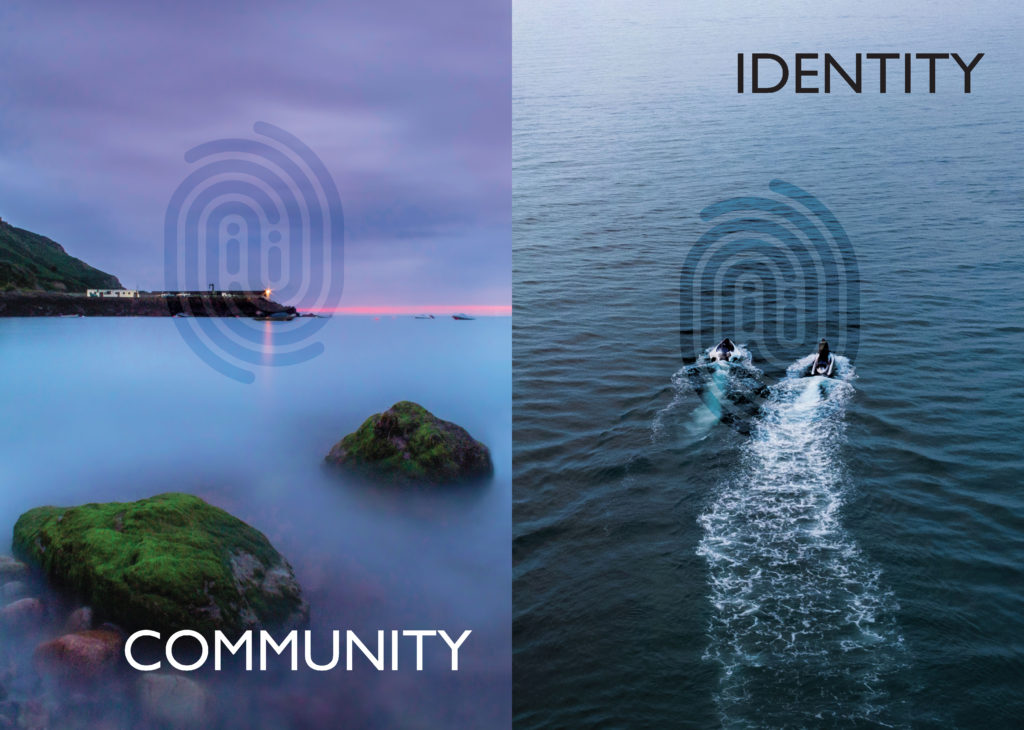
The newspaper was kindly sponsored by Deputy Carolyn Labey, Minister for International Development and Assistant Chief Minister who in her foreword shares her personal thoughts on what makes Jersey special to her in context of the Island Identity project led by her department. She says, ‘identity involves searching our soul, engaging with difficult issues, and asking not only who we are, but how others see us and what a vision for the future might look like. The perspective of students and young people in this debate is critical. Identity is a broad and far-reaching concept, one unique to all of us. This collection of images recognises both our differences and our commonalties. These times may be uncertain, but in my view the topic – ‘what Jersey means to you’ – is a fundamentally optimistic and forward-looking one.’
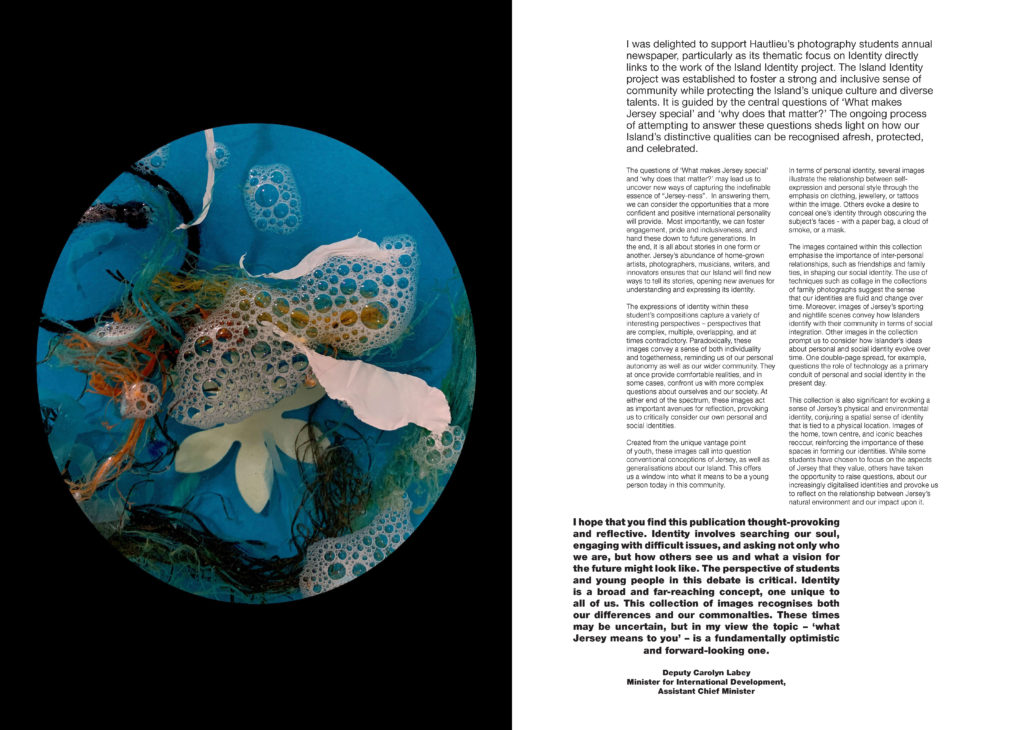
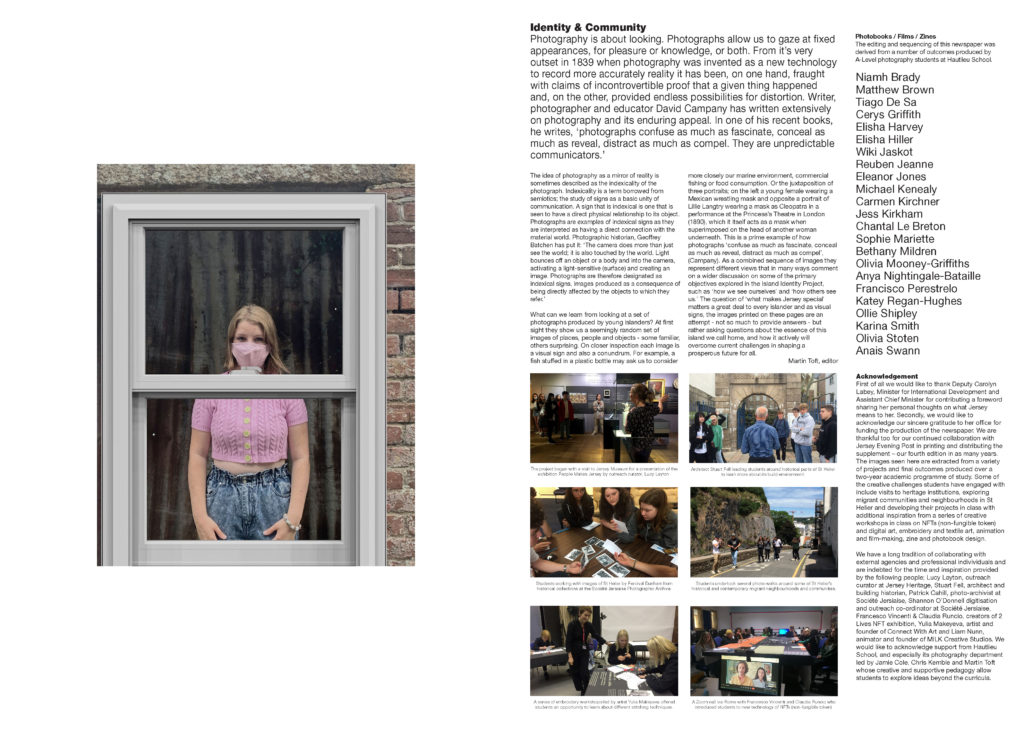
The Identity and Community newspaper is the fourth supplement produced in collaboration between Hautlieu School Photography Department and Jersey Evening Post. In 2018 the first issue was The Future of St Helier and last year the themes of Love & Rebellion explored experiences of isolation and lockdown during the coronavirus pandemic. Photographer and teacher Martin Toft, comments: ‘The question of ‘what makes Jersey special’ matters a great deal to every islander and as visual signs, the images printed on these pages are an attempt – not so much to provide answers – but rather asking questions about the essence of this island we call home, and how it actively will overcome current challenges in shaping a prosperous future for all.’
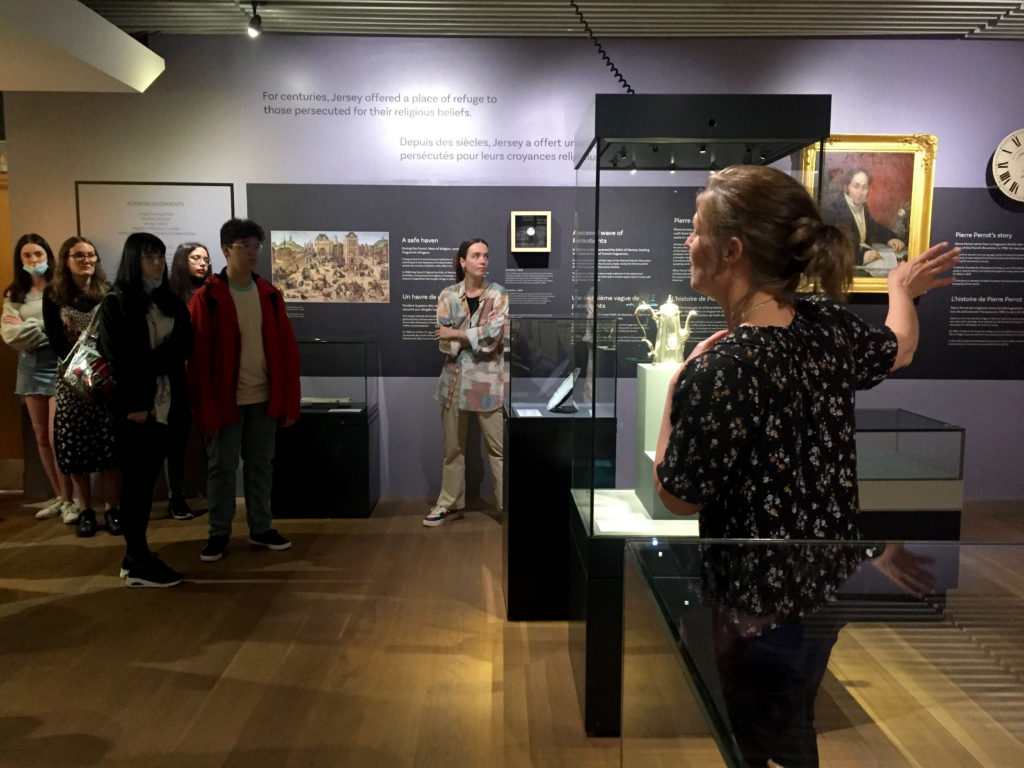
The image on the left of the first spread and the second double spread image are my selected images that have been included in the magazine.


I created my photo book using Adobe Lightroom Classic. Firstly I created a collection named ‘Photo Book’ and put all of the images I wanted to include in that collection folder:

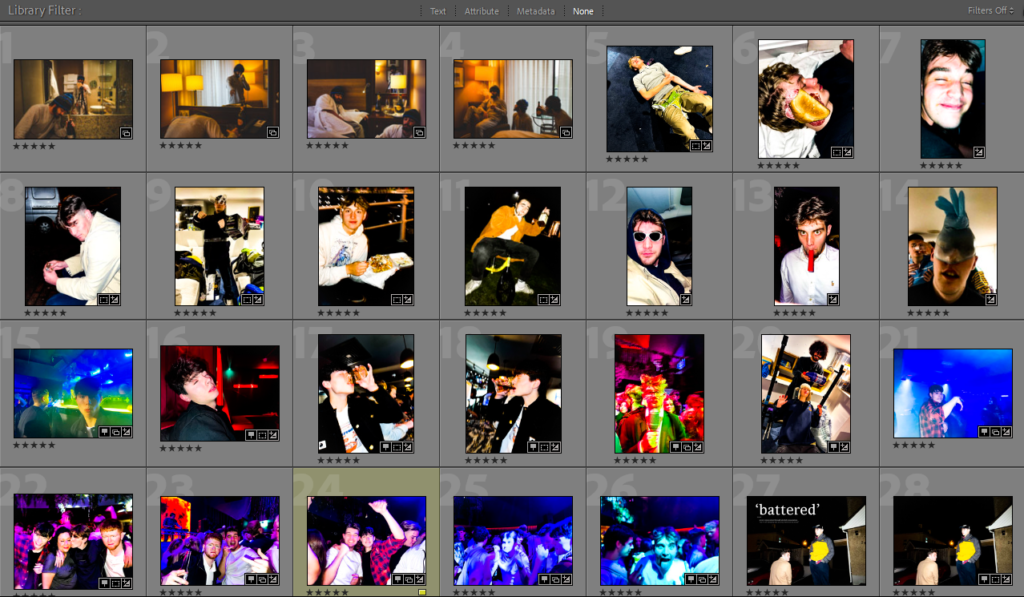

Next I put all these images into the ‘Book’ tab and ordered them in an aesthetic flowing order. I positioned the images in different places and in different sizes, as well as multiple and ingle images per double page to create variation throughout the photo book:
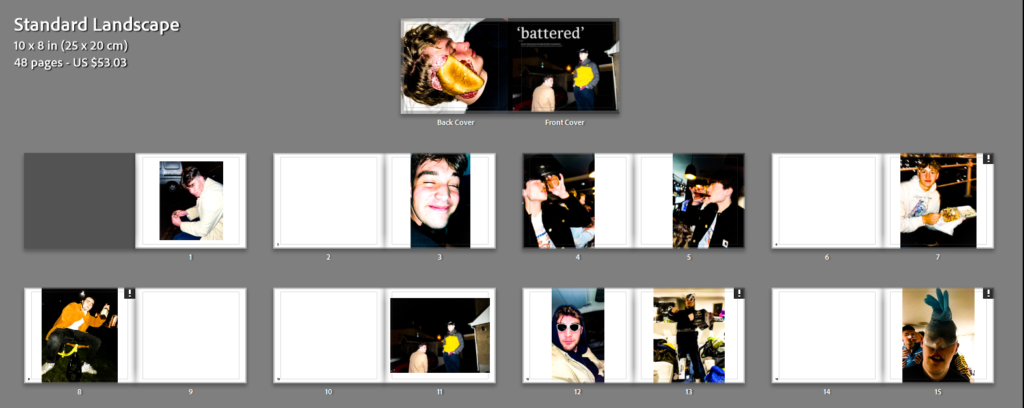



This shoot consisted of four different frames to produce four final edited images. Here is the contact sheet from the shoot:



In the style of Paul M Smith, I edited these images similarly to the other tableaux photo shoots I have done so far, creating a washed, grainy film look to the final image.
Similarly to the previous shoots, I took multiple photographs of the same frame with the same subject in multiple different positions in the shot. I used the same process and stages of editing as before too:









I repeated this process for another three sets of images from the shoot to produce these final images:

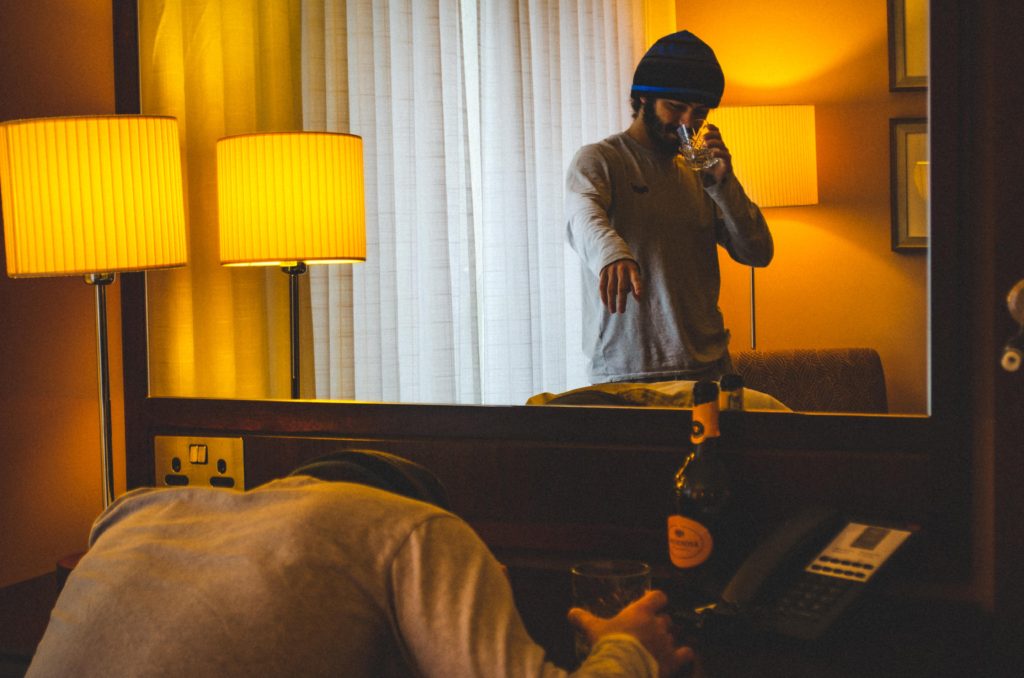


Here are my final edited photographic responses for Paul M Smith (the editing process is in later blog posts)






Here are the raw images from my second staged photo shoot:

Sticking with the style of Paul M Smith, I am going to edit these images to be slightly under and over exposed in certain areas and a washed grainy look to resemble film photography.
Again I took multiple photographs of the same frame with the same subject in multiple different positions in the shot.
Firstly, I selected the images I wish to use in the final edit. With this final image I wanted to have the subject in the frame five times, so I needed to select five images that work together when layering them. Here are the images I chose to use:





After I selected these images I layered them together and blended them in a way that looks most natural and not out of place. This required more blending and layers than the first shoot as more raw images were used:
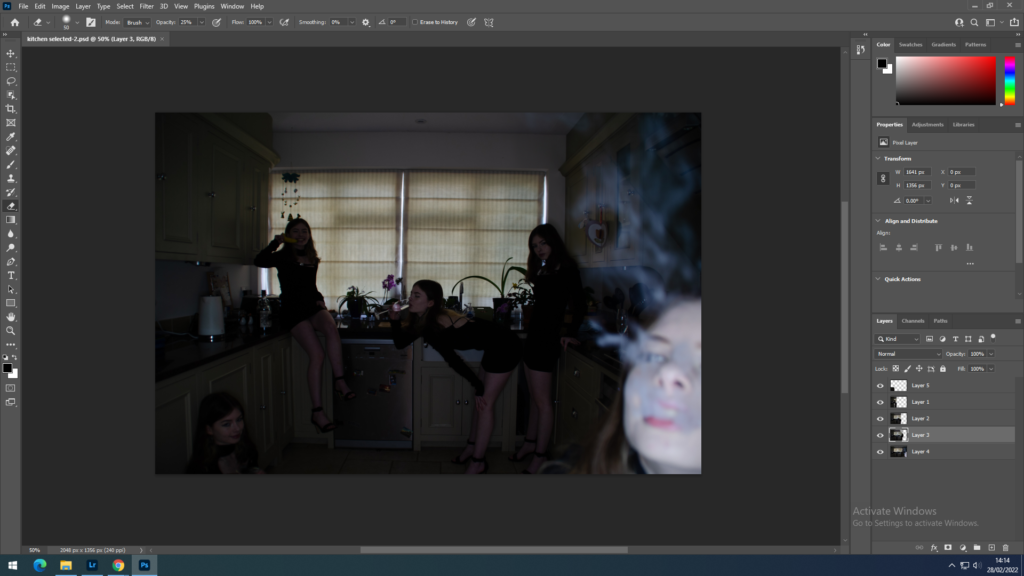

After this I exported this image and put I into Adobe Lightroom. Here I edited the image so that the shadows were lightened and the exposure was increased. I also added grain and texture to the image as well as a slightly warm hue similar to my first tableaux shoot to resemble that of a film camera:




Here is the final outcome:

How can photography explore identity between documentary and tableaux?
‘never judge a book by its cover’
I would like to explore the topic of identity, broadly as a whole, as well as how people can have multiple identities. The direction i would like to go with this is mainly Alone vs Social identity. I find this comparison interesting because of the contrast that can be created between the two through the actual contents of the image as well as how the image can be edited. Ideas like group photos with faces covered could show that they have a social identity as a group, but each individual has a separate identity and life of their own outside of that environment. I feel like this matters to me because it applies to me and my friends. We all have our own identities individually. But when we are together we have a group identity and show the social side of our identity, as well as our own personality and identity showing through too. I find that everyone has this contrast between their identity when they are by themselves and when they are with others, their personalities come together and show through the image, especially with friend groups, less with strangers. I think when people see the images created they will be able to relate to them, creating a deeper meaning and making the image more personal. I plan to have sets of multiple contrasting images of a person, perhaps at different points of their life, showing how they have changed and how they can be judged in a certain way because of their social situation. These images will be more thought-provoking, meaningful and perhaps metaphorical in their finished state. The main styles of photography I will use is formal portraiture and a more casual, candid style of portraiture, street and event photography, referred to as snapshots. These will include multiple subjects and mostly be ‘old-school’ and ‘vintage’ looking as if they were taken on a film camera. As well as these two contrasting styles, I will include images blending the two, with one subject alone, but in a social environment, showing that even though the person is in a social situation, they still have their individual identity. I will then edit these images to further bring out the meaning and emotion behind them. The photographer I will be exploring and analysing is Paul M Smith, specifically his project ‘Make My Night’ which examines ‘lad culture’ and herd mentality amongst young males but conceptualises it by using himself to act out all the individuals in the group.

I will also explore the work of Polish photographer Maciej Dakowicz, and his project called ‘Cardiff at Night’. This project explores the rowdy environment of Cardiff after dark. Maciej Dakowicz’s photographs are documentary images whereas Paul M Smith’s photographs are tableaux, creating an interesting comparison between the staged and ‘real’ images, but both heavily explore ideas of identity in similar ways.

In a nutshell, documentary photography doesn’t only have one specific meaning, it includes a range of photographical approaches. it may be similar to photojournalist and street photography, but will never include a staged or posed scene. Documentary photography is used to display what is really happening out in the world, to tell a story or document an event usually through a series of photographs. The reason for documentary photography is to show what life is like at the time the photograph was taken, to tell a story without altering the contents of the shot for a ‘better’ photograph. As well as this, it can be used personally too, to document your family history or to tell your own story.
Maciej Dakowicz uses documentary photography to display what life is really like in Cardiff at night. The term ‘documentary’ was originally used in a review of a film by Robert Flaherty in 1926, by John Grierson, a British film director. The context of this is he was describing how the film seemed true to what was real, showing what life is like without changing a thing for the camera. Soon after, the term ‘documentary’ was used in photography too starting with some photographers describing their work as ‘documents’. Photographer Eugene Atget was the first to describe their work as ‘simply documentation’ when talking about his images of Parisian streets in the early 20’th century and other photographs where the photographer was seeking social change.
The start of documentary photography is shown to be linked with the development of print photography in the 1920’s and 1930’s and mass press photo magazines and newspapers. These images used in the magazine and newspaper articles were the start of the contemporary photojournalism movement. These new photographers were reporters who bring back visual knowledge to tell a story or what is happening in the world.
Documentary photography includes a range of different photography styles, all used in different events and situations to put across the desired meaning and story by the photographer including reporting, street-photography and photojournalism. These could be used for institutions, mass media, fine art and science, as well as story telling and documenting personal experiences.
Paul M Smith was born in 1969 in England and is a British photographer and educator.
He studied fine art at Coventry University from 1991 to 1995. Whilst studying he explored the meaning and construction of masculinity, focusing on the ‘alpha male’ identities.
One of Paul Smiths projects which caught my eye was ‘Make My Night’. Here he displays his take on the male identity having a ‘laddish’ night out. he did this by merging many self portraits together and layering them to make it seem as though he appears multiple time in the frame.

Here Paul M Smith takes the role of ever character in the frame, he becomes the ‘anonymous everyman’. He has set up the camera in a singular position and taken multiple frames of himself in different positions, editing them to make it seem as if the characters are interacting with each other. This type of photography drew my attention because of its ‘in the moment’ quality. They appear ‘professionally unprofessional,’ in the sense that some aspects are fuzzy, out of focus, or over/underexposed. However, these ‘unprofessional’ qualities add character to the shot, making it one-of-a-kind and seem as if someone just took out a disposable camera to take a quick photo. These images show the hectic events of a ‘lads night out’ whilst keeping a personal feel. The photos seem similar to ones in a personal photo album, memories that have been captured in the spur of the moment with little thought.
Paul M Smith heavily explores the idea of identity through his work. He does this using multiple techniques that blend together to create a sense of group identity within the image. One technique he uses is POV framing. This is where the photograph is taken from the point of view as someone at the event, making the viewer feel more involved in what’s happening in the image as well as getting a better idea of the group identity being portrayed. Another method Paul M Smith uses is editing the contents of the image so that every character in the frame is the same person. This also creates a feeling of group identity within the image singe they are all interacting with each other. The actual contents of the images explores the rowdy and hectic stereotype of men on nights out, drinking and smoking etc.
Maciej Dakowicz is a popular Polish Photographer. He is an official Fujifilm X-Photographer and a member of a street photography group called UP photographers. One of his projects is called Cardiff After Dark which is his first monograph. The project consists of photographs he took over the course of 6 years from 2005 to 2011 of the hectic atmosphere at night of Cardiff over the weekend.

The images are focused around pedestrians out in the streets of Cardiff, drinking and smoking.
These are the best unedited images from my documentary photography shoots for my photo book:
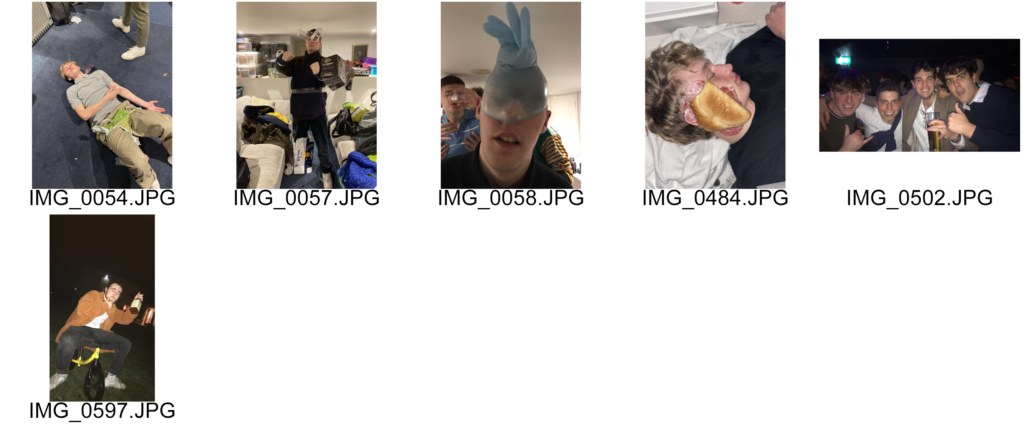
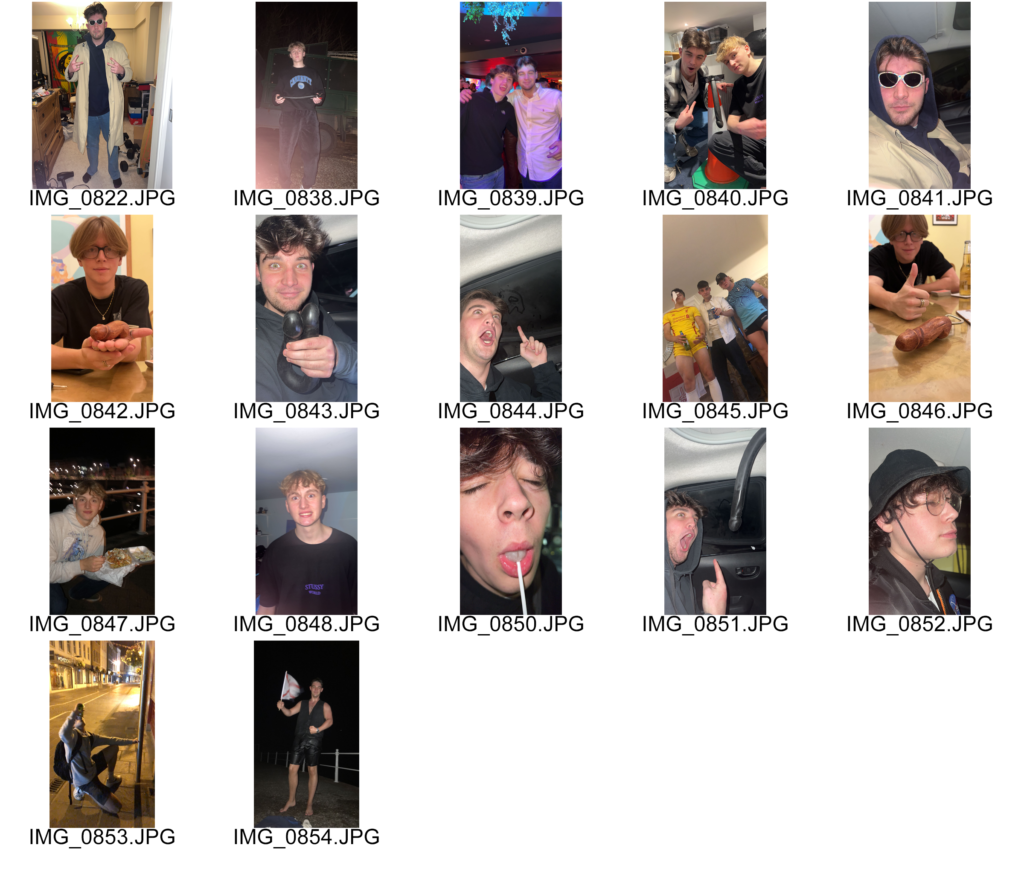
I used Adobe Lightroom Classic to edit these photos;
First i imported the images and rated them 1-5 to organise them:

I then used the develop tab to edit the individual photos. I altered the images to look similar to film photography to resemble the style of Paul M Smith’s project ‘Make my Night’:

These are my best edited images from the documentary shoots:



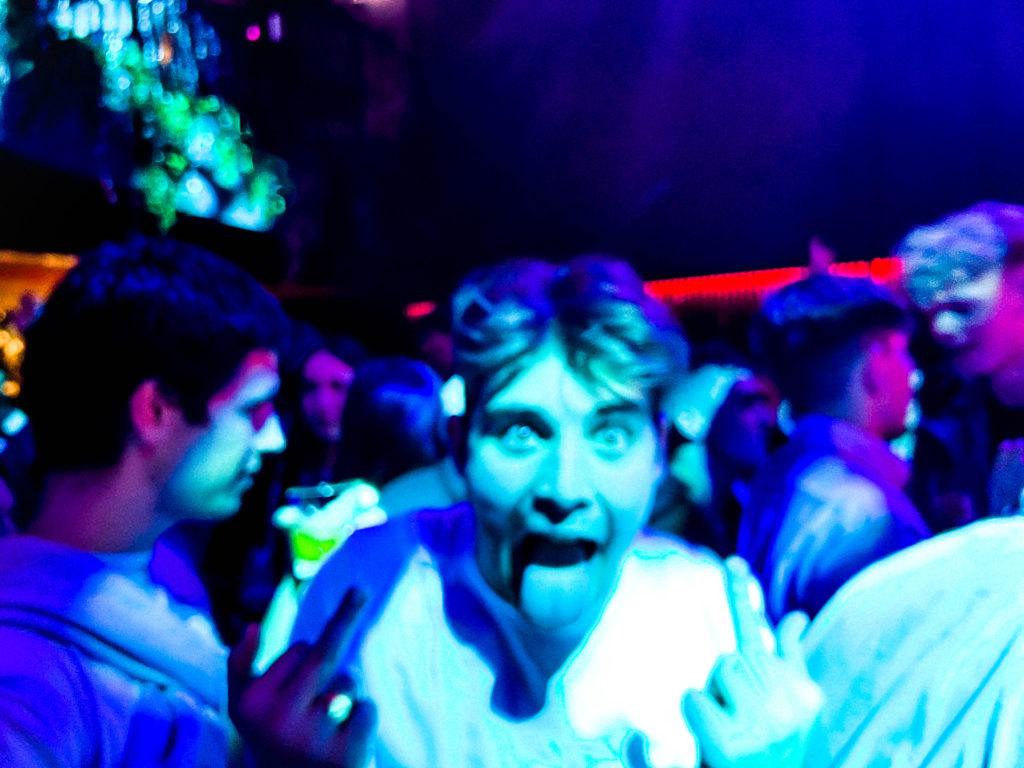



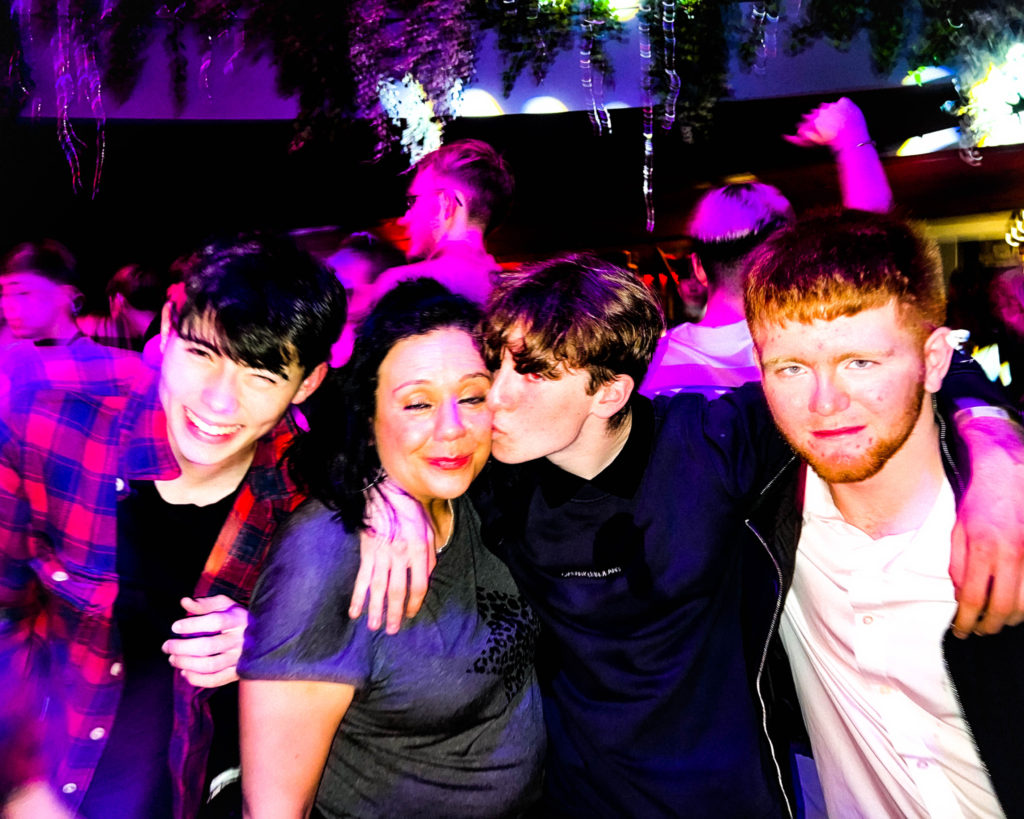

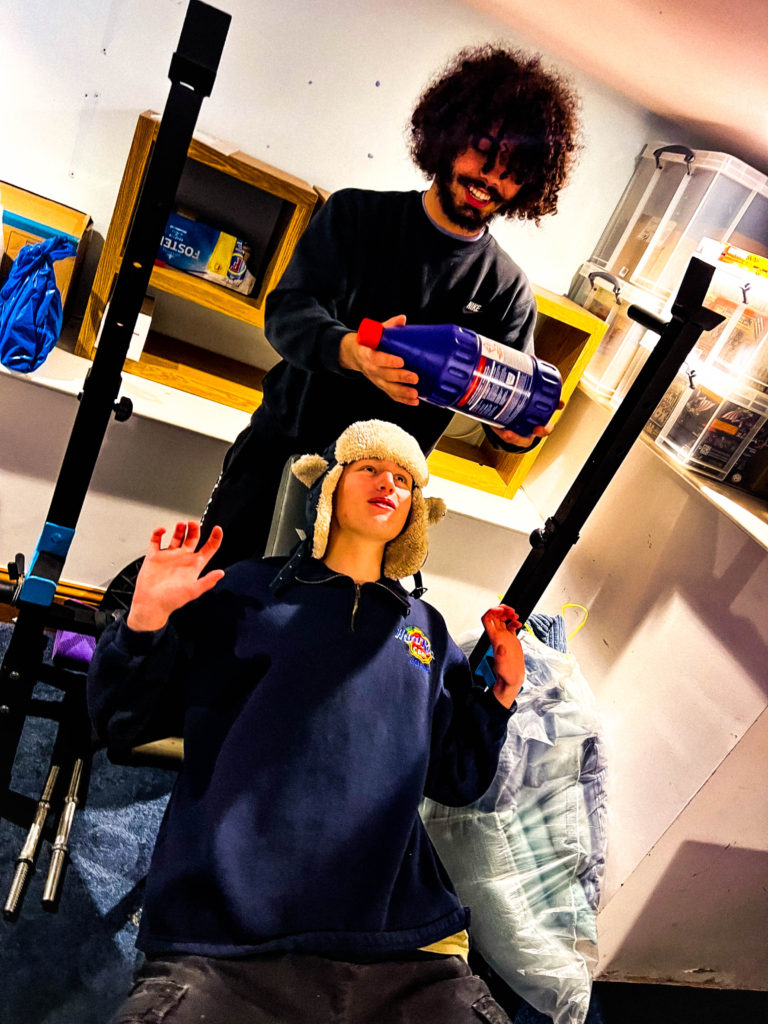

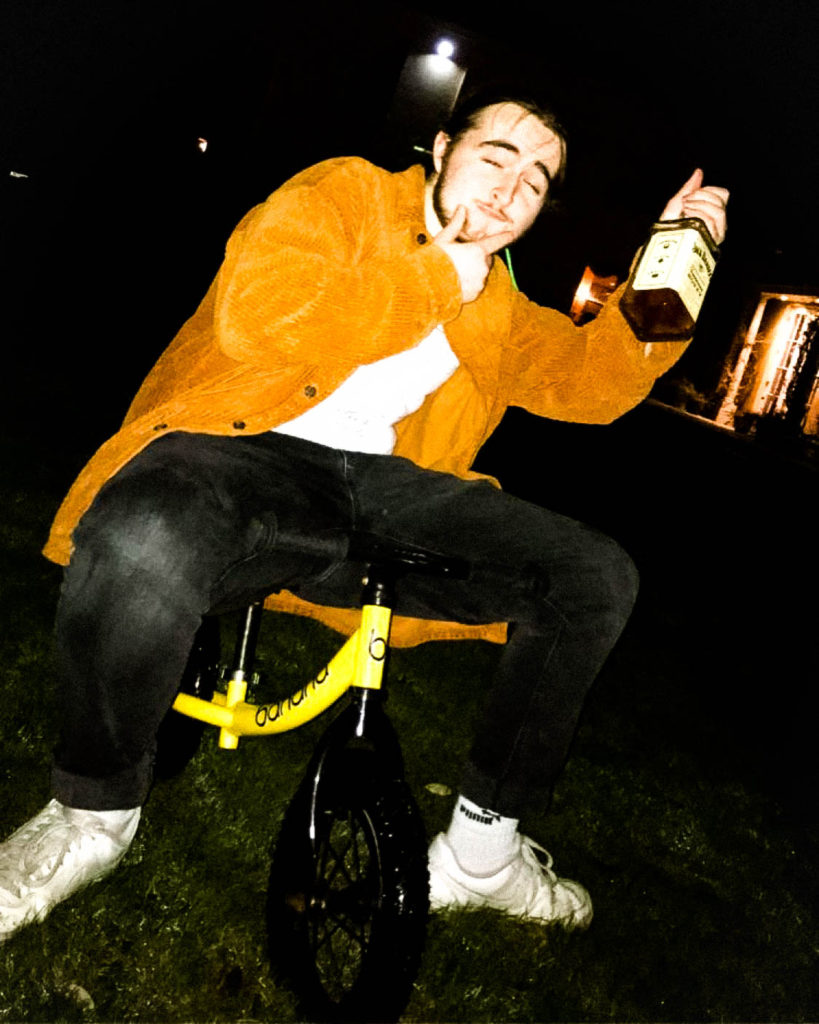
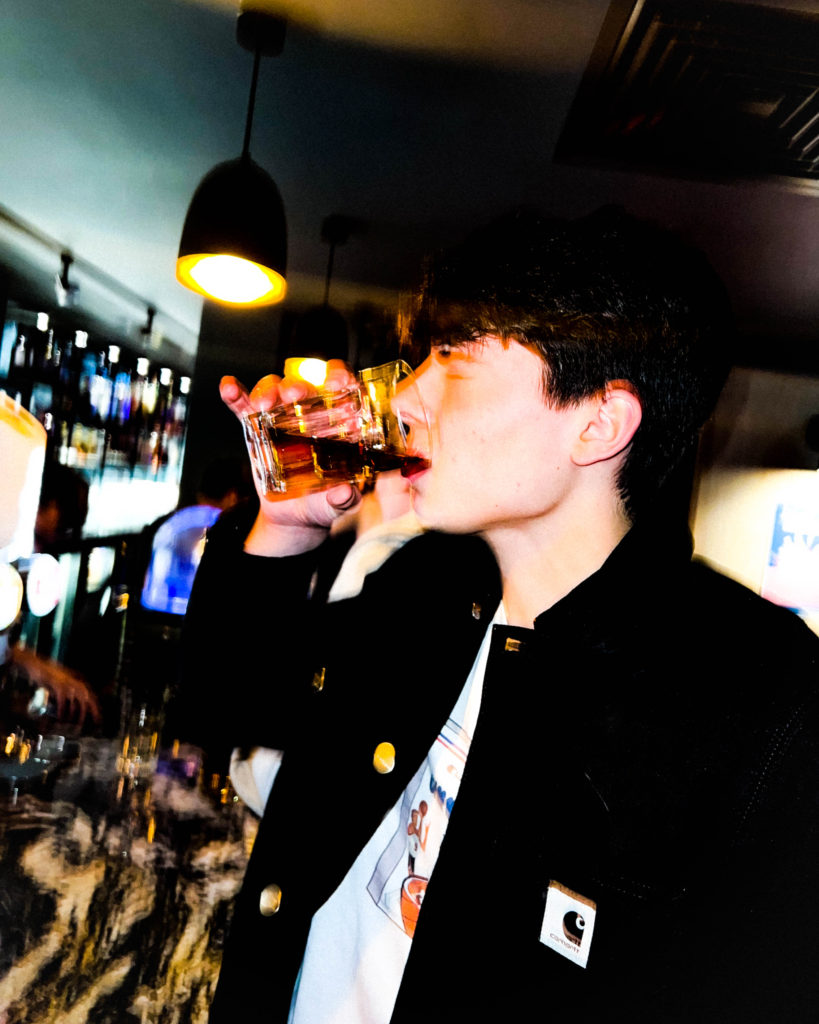



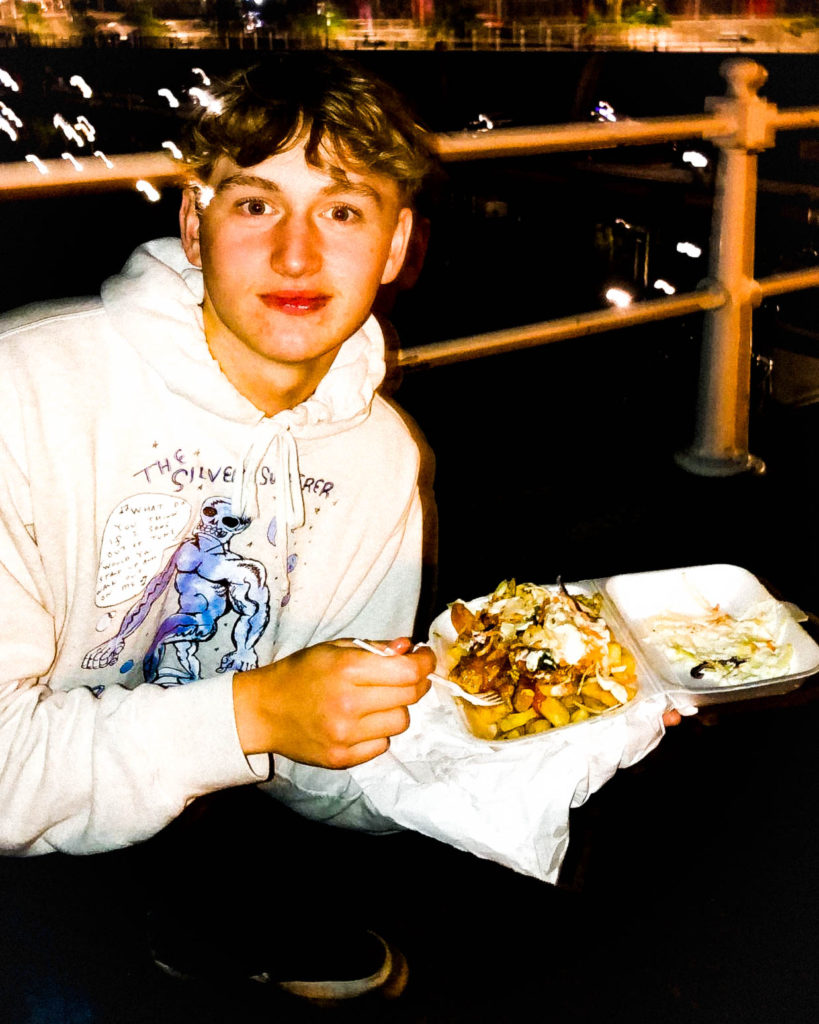

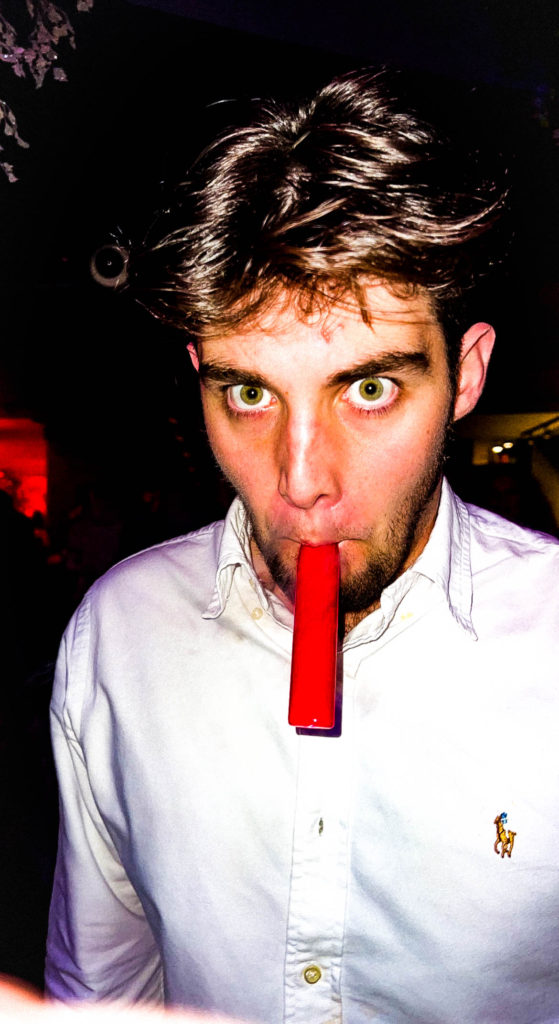


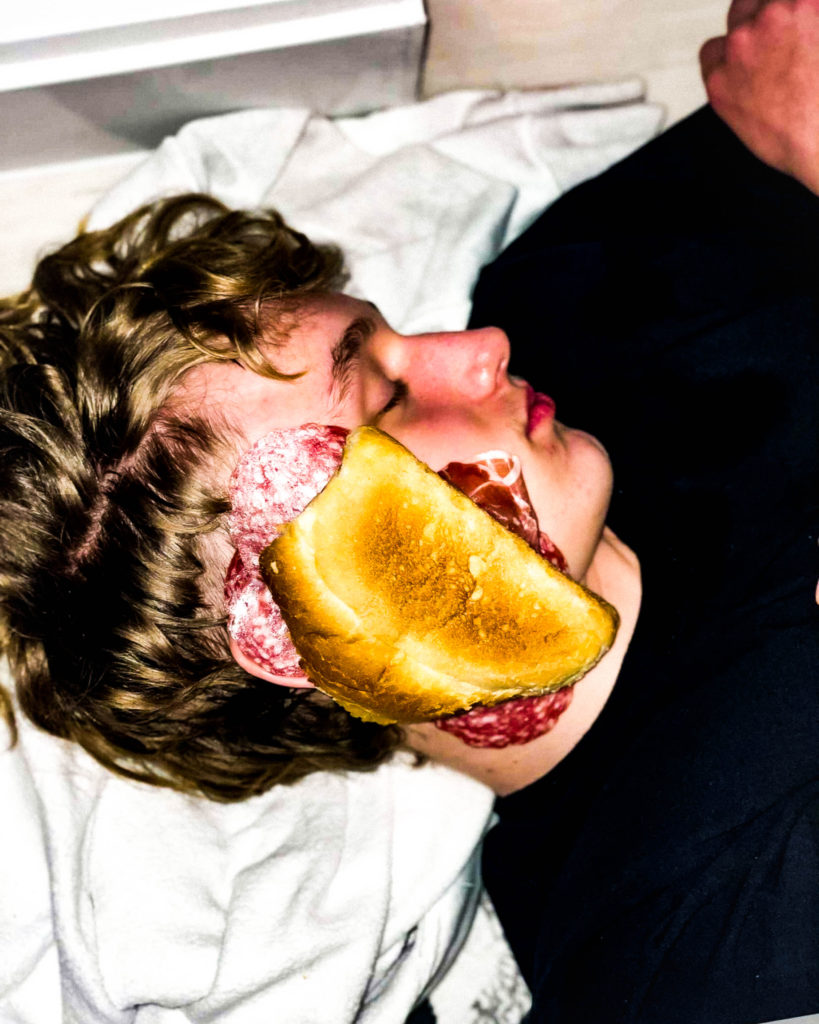
Photography was invented in 1839, which as the year a frenchman, Louis Daguerre, and an Englishman, Henry Fox Talbot, announced processes that would ‘fix the shadows’.
‘Camera Obscura’ is an optical phenomenon that is easy to create and hard to believe. It is a blacked-out room with a small hole in a wall that allows a tight beam of light to enter, projecting an upside-down image of the outside world.

It had been known for centuries what camera obscura could do, the breakthrough came with the observation that certain chemicals were light-sensitive. Talbot experimented using paper coated with silver salts and shoebox-sized cameras which were nicknamed ‘mousetraps’. This first created negative images which were laterally reversed, which represented the breakthrough in which modern photography would be founded.
In 1839 Louis Daguerre had news that he had his own method of ‘fixing the shadows’, and this method was very different from what Talbot had discovered. instead of a paper-based process, he fixed his images on a mirrored metal plate, which were one-off images like a polaroid, creating a unique visual experience, these were known as a Daguerreotype. The silver grains of the image sit on top of the image, what you see on a Daguerreotype is light reflected back through an image. But one downfall of this method is that only one image could be created through this process, whereas Talbots method could create multiple.
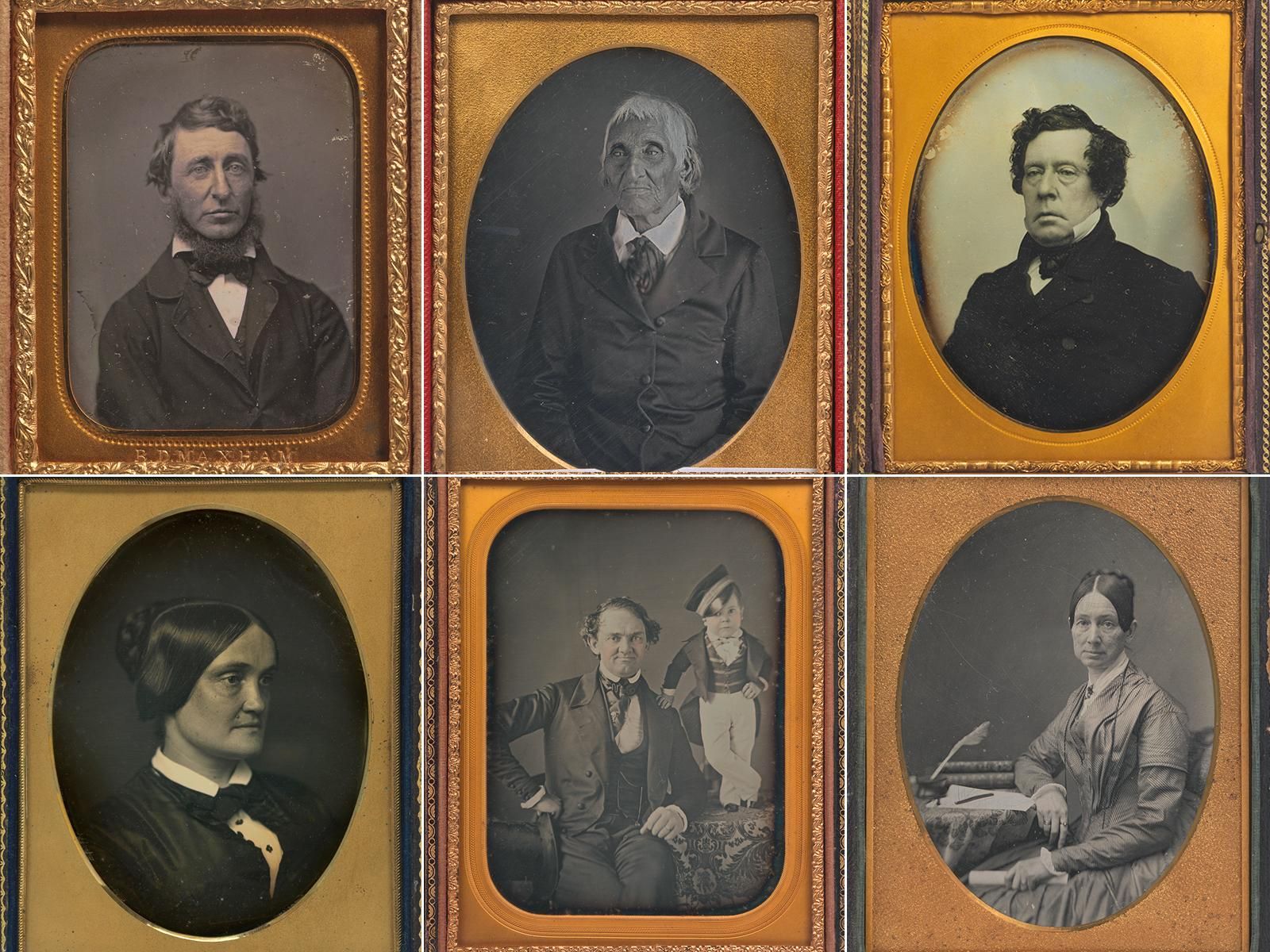
Nadar was a photographer who took natural-looking portraits. His portraits of artists are unrivalled because he photographs them as equals. He doesn’t have to dress them up or tell them to act a certain way, he photographs them just standing in his studio making them authentic and unique to other portraits at the time.
George Eastman revolutionised photography in many ways, firstly by creating the first rolls of film, and by creating the Kodak camera. This was originally a handheld, moderately expensive camera for people to have at home and to be able to take photos without being a photographer. “You press the button, we do the rest”
These film rolls would be sent to Kodak and would be printed and sent back to the user so they don’t have to develop the film themselves.

To reduce the price of cameras and promote it, Eastman came up with The Brownie Camera. It was cheaper to make, develop and buy film for. It was initially intended to be a child’s camera, costing $1 with a roll of film only being 15¢ and processing costing 40¢.

Kodak didn’t just change what was happening behind the camera, but also what was in front of it, it changed how people reacted to a photo being taken of them, for more or less the first time people looked at the camera in the eye and smiled.
The amateur snapshot is a small sub-category of vernacular photography. Vernacular photography were everyday photos, photos that had no artistic value. It contained some of the world most naturally occurring images.
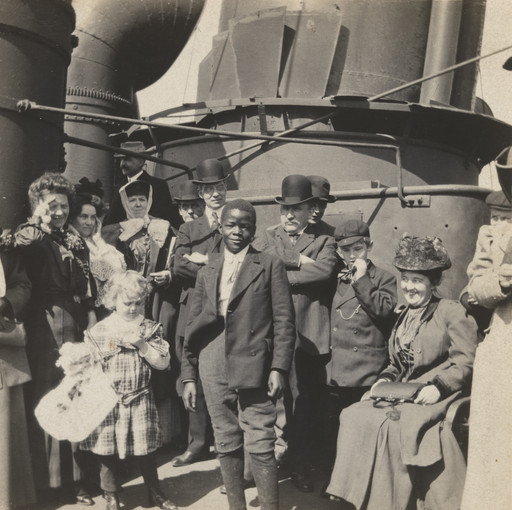
The digital camera revolutionised photography as a whole. The digital camera was invented in 1975 by Steven Sasson, an engineer with Eastman Kodak. The loss of film and the use of electrical signals to create and store images.

Following the success of Artists Rifles, Paul re-joined the discourse with the masculine identity in Make My Night. Ostensibly a record of a very laddish night out, Paul used a similar technical method to that of the previous series combined with the use of multiple self-portraits. As before, he becomes the anonymous everyman but this time is more overtly the narrator as well as the protagonist of a frequently observed ritual – here

Governed by group approval and time honoured rites, a world of bravado and sexual tension vies with drunken frivolity and a certain vulnerability to occlude any notion of a new masculinity. From the preamble of high jinks and drinking games, to bar fights and stand offs through to its nauseous conclusion, each scene has been painstakingly researched and detailed – here

This style of photography caught my eye because of the ‘in the moment’ feel of them. They appear to be ‘professionally un-professional’ in the sense that some aspects are blurry, out of focus or over/under exposed. But these ‘un-professional’ aspects add a character to the photograph that makes it unique and captures the ‘vibe’ of the room at the time, hectic and busy.
Paul M Smith was born in 1969 in England and is a British photographer and educator.
He studied fine art at Coventry University from 1991 to 1995. After completing his degree he completed a masters degree in photography at the Royal College of Art. Whilst studying he explored the meaning and construction of masculinity, focusing on the creation of various ‘alpha male’ identities.